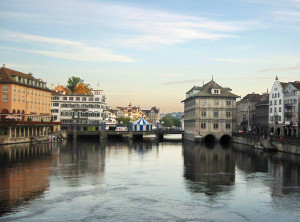The Romans founded Zurich in 15 B.C. along the Limmat River that flows north from Lake Zurich. The lake and the nearby Glarus Alps whose melting glaciers feed it create one of the most picturesque backdrops of any city in Europe. During the middle ages, Zurich was a self-governing city-state and member of the Swiss Confederacy.
In 1518, Ulrich Zwingli became priest of Zurich’s Grossmunster Church. Like Martin Luther, his contemporary in Germany, Zwingli sought to reform the Roman Catholic Church but soon concluded reform was impossible. By 1528 about half the cities of the Swiss Confederacy had followed Zwingli in rejecting the authority of the Pope. Like the later John Calvin in Geneva, Zwingli preached discipline, thrift and self-reliance, instilling in Zurich what became known as the “Protestant ethic.” Many consider Zwingli, killed and mutilated in a major battle between Swiss Catholics and Protestants in 1531, one of the fathers of the Reformation, along with Luther and Calvin.
Under the 1848 constitution creating the Swiss federal government, Zurich became the capital of the Zurich Canton. The city is governed by a citizen assembly meeting in the old town hall curiously located in the river. Influenced by Zwingli, Zurich has long deserved its reputation for efficiency, integrity, prosperity and, some would say, dullness. Zurich has lately cultivated a different side, reportedly now sporting the highest night club density of any city in Europe to go along with its 50 museums.
The marriage of hard work by day with partying by night has succeeded, with recent surveys identifying Zurich as the city having the world’s best quality of life. It has also become one of the world’s most cosmopolitan cities, with one of every three residents born in another country. The gnomes of Zurich are hiding no more.

Comments are closed.